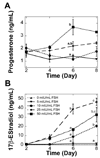Regulation of mouse follicle development by follicle-stimulating hormone in a three-dimensional in vitro culture system is dependent on follicle stage and dose
- PMID: 15987824
- PMCID: PMC2662519
- DOI: 10.1095/biolreprod.105.042390
Regulation of mouse follicle development by follicle-stimulating hormone in a three-dimensional in vitro culture system is dependent on follicle stage and dose
Abstract
The developmental requirements of ovarian follicles are dependent on the maturation stage of the follicle; in particular, elegant studies with genetic models have indicated that FSH is required for antral, but not preantral, follicle growth and maturation. To elucidate further the role of FSH and other regulatory molecules in preantral follicle development, in vitro culture systems are needed. We employed a biomaterials-based approach to follicle culture, in which follicles were encapsulated within matrices that were tailored to the specific developmental needs of the follicle. This three-dimensional system was used to examine the impact of increasing doses of FSH on follicle development for two-layered secondary (100-130 microm; two layers of granulosa cells surrounding the oocyte) and multilayered secondary (150-180 microm, several layers of granulosa cells surrounding the oocyte) follicles isolated from mice. Two-layered secondary follicles were FSH responsive when cultured in alginate-collagen I matrices, exhibiting FSH dose-dependent increases in follicle growth, lactate production, and steroid secretion. Multilayered secondary follicles were FSH dependent, with follicle survival, growth, steroid secretion, metabolism, and oocyte maturation all regulated by FSH. However, doses greater than 25 mIU/ml of FSH negatively impacted multilayered secondary follicle development (reduced follicle survival). The present results indicate that the hormonal and environmental needs of the follicular complex change during the maturation process. The culture system can be adapted to each stage of development, which will be especially critical for translation to human follicles that have a longer developmental period.
Figures







References
-
- Dorrington JH, Moon YS, Armstrong DT. Estradiol-17β biosynthesis in cultured granulosa cells from hypophysectomized immature rats: stimulation by follicle-stimulating hormone. Endocrinology. 1975;97:1328–1331. - PubMed
-
- Kumar TR, Wang Y, Lu N, Matzuk MM. Follicle-stimulating hormone is required for ovarian follicle maturation but not male fertility. Nat Genet. 1997;15:201–204. - PubMed
-
- Dierich A, Sairam MR, Monaco L, Fimia GM, Gansmuller A, LeMeur M, Sassone-Corsi P. Impairing follicle-stimulating hormone (FSH) signaling in vivo: targeted disruption of the FSH receptor leads to aberrant gametogenesis and hormonal imbalance. Proc Natl Acad Sci U S A. 1998;95:13612–13617. - PMC - PubMed
-
- Abel MH, Wootton AN, Wilkins V, Huhtaniemi I, Knight PG, Charlton HM. The effect of a null mutation in the follicle-stimulating hormone receptor gene on mouse reproduction. Endocrinology. 2000;141:1795–1803. - PubMed
-
- Fauser BC, Van Heusden AM. Manipulation of human ovarian function: physiological concepts and clinical consequences. Endocr Rev. 1997;18:71–106. - PubMed
Publication types
MeSH terms
Substances
Grants and funding
LinkOut - more resources
Full Text Sources
Other Literature Sources
Medical

